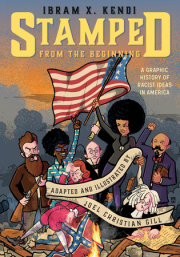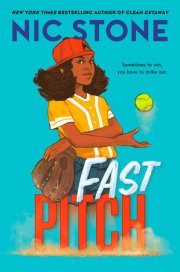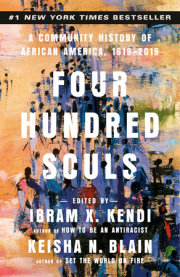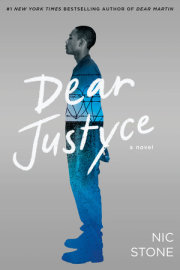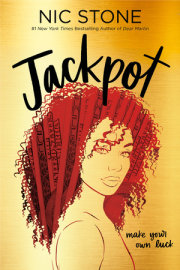A Brief Word before We Begin . . .
As I’m sure you’ve deduced from that whole “Inspired by the #1
New York Times bestseller
How to Be an Antiracist” statement on the cover, this book is . . . inspired by the #1
New York Times bestseller
How to Be an Antiracist, the paradigm-shifting memoir written by Dr. Ibram X. Kendi.
And the
inspired by is very important. Because
this book is structured differently than its source of inspiration. Hence me, your beloved narrator, Nic Stone, including this
pre-intro as a bit of a road map for the nonlinear journey you’re about to take through Dr. Kendi’s life.
Said journey is broken up into three parts (or
acts, if we want to get all narratively fancy with it):
INSIDE: Facing Yourself
The concepts covered here—definitions, dueling consciousness, power, biology, behavior, Black, and White—are all about turning inward and are focused on examining the paradigms, aka foundational thoughts and ideas, that form our views of ourselves and other people.
OUTSIDE: Facing the World
Once we’ve done some self-examination and rejiggering, it’ll be time to turn outward and take a microscopic-level look into the ways that racism permeates the world we live in and intersects with other forms of people being awful to each other. We’re talking color, ethnicity, body, gender, orientation, class, culture, and space.
UPSIDE DOWN: Flipping the World Over
This is where we get about that action, boss. We’re moving from failure to success and digging into what
I—Nic—call the Four C’s of Changemaking: cogency, compassion, creativity, and collaboration. We’ll also make sure we have a solid grip on the power of pushing forward in spite of obstacles. And I know that a lot of you readers feel like you’re ready to
get out there and
tear down the vile walls of racism, so, like, why not just jump to this section first, right?
Well, you
could, obviously . . .
But in my humble opinion, it would behoove you to read the other two sections first.
Because as you, dear reader, will come to discover, being antiracist is more than a quick and easy decision you make. (And you don’t have to make it right now, by the way. Do yourself—and the world—a favor by reading the book first.)
Being antiracist is . . . Well, I won’t spoil it.
Just buckle up and get ready for the ride.
BEGINNING IN THE MIDDLE: Your (Racist) Introduction
The year is 2000, and you, Ibram X. Kendi, are seventeen years old.
You hate wearing suits. And ties.
Hate it.
Today, though, you’re in a suit
and tie—black button-down, black slacks, golden-brown blazer, slick boots the color of the half-and-half you’ve seen adults pour into coffee, and the brightest, boldest tie you could find. You’re also standing somewhere you never expected to be, about to do something you never expected to do.
It’s your senior year of high school, and you’re mere months from graduation. Getting
there felt like a hard-fought battle with one arm tied behind your back. So being
here? In this chapel with upward of three
thousand people seated in rows that curve around the long, arched pulpit, all waiting to hear what YOU have to say? Flanked by two other Black high schoolers also dressed to the nines and waiting for their turns at the mic?
Yeah, this feels real good.
It’s the perfect cap to a series of events that turned your world—both outer and inner, your sense of yourself and your capabilities—completely upside down. True, your competitors in the final round of the Prince William County Martin Luther King Jr. Oratorical Contest are a lot (book) smarter than you are. They certainly get better grades than the ones that make up your sub-3.0 GPA. And their SAT scores are hundreds of points higher than yours. You barely cracked 1000 . . .
But you are
here, just like they are.
You won your high school oratorical competition, as you presume they did. You moved on to a countywide round, which they did as well. You were voted “best before the judge,” which is how you wound up right here beside them on this makeshift stage.
And the best part: Just like them, you’re headed to college.
Now, this might not
sound like a huge deal—
obviously, you’re eventually going to college, right? Your parents both went, and from what you’ve heard, that’s what all smart people do after graduating from high school. No-brainer.
The truth is, though, for a while you didn’t feel very
smart. You’d dropped out of your IB English class because you couldn’t get your head around Shakespeare.
There’s no way I’m smart enough for a university, you thought.
But being on this stage isn’t the first time you’ve been proven wrong about yourself. And as you’ll soon come to discover, the fiery speech you’re about to give is only the beginning.
The whole college thing had come as a huge surprise: A few weeks prior, you’d been minding your basketball business, running layup lines during a typical pre–home game warm-up session. Catch the pass, dribble forward, then gently leap and let the ball roll off your fingertips. Run to the opposite line and repeat.
But then the gym door opened, and in strode your dear ol’ dad. Six-foot-three and two hundred pounds. Waltzed right onto the court, long arms waving to get your attention.
Your gut reaction: wide-eyed, breath-stopping embarrassment. As much as you love your pops, his blasé-blah attitude toward what you’ll eventually come to call the “White judge”—a personified name for the overwhelming sense that power-bearing White people are evaluating your every move . . . something Dad couldn’t care less about—really got under your skin back then. Prevent his true feelings from showing on his face? Nope. Keep his voice down? No way. Avoid making any sort of scene? Forget about it.
It scared you to have an African American father who lived by his own rules. It was the precise type of attitude that might’ve gotten him lynched in the past or shot down by a vigilante civilian or law enforcement official now.
But at any rate, there he was. So you jogged over to meet him.
He looked really geeked. Which was weird.
When you reached him, he handed you an envelope. Told you to open it. Like . . . right then and there at the half-court line before a game. With
everybody watching. Including all the White people.
Of course, you complied.
It was an acceptance letter from Hampton University, one of the two colleges you’d applied to for the sole purpose of being able to say you’d tried.
That acceptance letter flipped your worldview on its head. Despite the test scores and report cards, you were smart enough to go to college after all. The other school you applied to, Florida A&M University, is the one you’ll wind up attending, so you clearly got in there too (though you don’t know that yet).
Standing on that court in front of your dad, a number of faulty ideas faded from your mind. So did your sense of what you would later come to know as the “White gaze.” With that letter in your hand, the stuff you believed about “intelligence” being proven by grades and test scores? It lost a bit of its validity.
Granted, you’ve still got a lot of ideas to unlearn and replace. You’re not yet a reader, but you will be soon. And eventually, you’ll look back and see a number of things through a cleaner lens.
But this moment on the basketball court is one you won’t forget. It’s the moment you awaken to the idea of something . . . more.
Now back to the MLK oratorical contest. You’re up first.
And before you begin, you should know: You’ll come to recall the “speech” you’re about to give with . . . the
opposite of pride.
For now, though, you’re fired up. Ready to roll. Primed and pumped to share what
you think is an updated version of Dr. King’s dream.
So you take your place, and you begin.
“What would be Dr. King’s message for the millennium?
“Let’s visualize an angry seventy-one-year-old Dr. King . . .”
[It was joyous, our emancipation from enslavement . . . But . . .]
“Now, one hundred thirty-five years later, the Negro is still not free . . .
“Our youth’s minds are still in captivity!“They* think it’s okay to be those who are most feared in our society!
“They think it’s okay not to think!
“They think it’s okay to climb the high tree of pregnancy!
“They think it’s okay to confine their dreams to sports and music!”
*They as in Black youth.
(Applause, applause, and more applause.)
“Their minds are being held captive, and our adults’ minds are right there beside them.
“Because they somehow think that the cultural revolution that began on the day of my dream’s birth is over.“How can it be over when many times we are unsuccessful because we lack intestinal fortitude?”
(Everybody claps.)
“How can it be over when our kids leave their houses not knowing how to make themselves, only knowing how to not make themselves?”
(Everybody claps.)
“How can it be over if all of this is happening in our community?”
And then . . . with everyone at the edge of their seats, hanging on your every word, you drop your voice for the finale:
“So I say to you, my friends, that even though this cultural revolution may never be over,
“I still have a dream . . .”And the crowd goes
wild.
A crowd full of African American adults. (You’re in a Black church, after all.)
Validation.
But the thing is . . . you’re wrong. And everyone who agreed with you by way of applause is also wrong.
It’ll take you some time to realize that your words aren’t as virtuous as the resounding applause has made you believe they are. Eventually, you realize that it’ll take more than a surprise pair of college admission letters and a spot in the finals of an oratorical contest to shift your sense of yourself and other Black people.
In this moment, though, with the approval of Black men, women,
and children ringing in your ears, you don’t realize it . . .
But everything you said is racist.
Later, you’ll wonder: Was it your poor sense of yourself that generated your poor sense of your people? Or was it your poor sense of your people that fueled your poor sense of yourself?
Both were evident in that speech.
For instance . . .
You mentioned
our youth’s minds being “in captivity” . . . but what exactly are they in captivity to?
You mentioned Black youth’s okay-ness with being feared . . . but is that their fault alone?
Your mentioned Black youth being cool with not thinking . . . which is little more than a remix of the old adage that Black kids don’t value education as much as their non-Black counterparts. But is that actually true?
Number three is particularly
insidious—a word you’ll come to use that basically means EVIL in a dastardly villain–type of way. Because it hasn’t occurred to you that even
you had fallen prey to the precise thing you were shouting down. Remember your shock at getting into not one, but
two colleges? Said shock came from your belief that you were a lousy student. Thing is, that mess you spouted came from
messages—from Black people, White people, and the media—that told you the lousiness was rooted in your race. That (naturally) put a damper on your motivation to put forth more effort, which then reinforced number three up there: Black people just aren’t very studious.
On and on the cycle went because you’d bought that racist idea hook, line, and sinker. To the point where you were primed and ready to preach it—and the others—to a crowd full of Black people on MLK Day in the form of a revised “I Have a Dream” speech.
That’s the thing about racist ideas: They make people of color think less of themselves . . . which makes them more vulnerable to racist ideas (these are
internalized racist ideas, but we’ll get to that later). And then on the flip side, the same racist ideas make White people think
more of themselves, which further attracts them to racist ideas. And all of this tends to happen inside of people without anyone realizing it. Yourself included.
Because that’s the goal of that dastardly villain, Racist Ideology: It manipulates us into thinking
people—and therefore people
groups—are the problem instead of the
policies that perpetuate the racial inequities.
But we’re getting ahead of ourselves.
What you need to know before we jump back in time to the
beginning of your story:
Racism is real and dastardly villainous, and denial is what keeps its ugly heart beating.
Racist is more an adjective than a noun, and it’s
not an insult; anyone who
takes it as an insult or tries to
use it as one likely doesn’t know what the word actually means.
Not racist is not a thing in the fight for a more equitable world; there is
racist and there is
antiracist.
Color-blind as applied to race is also not a thing; it, like
not racist, is a part of the denial that keeps lifeblood pumping through that ugly and insidious heart of
racism.
At this point in your life, you are racist most of the time. Yes, you read that right. You, IXK, a young
Black man, currently subscribe to a
lot of racist ideas.
But you won’t forever. And that’s what this book is about: the journey to being fully human and to seeing others as fully human.
And you will come to see the movement from
racist to
antiracist as always ongoing—requiring understanding and snubbing racism based on flawed ideas about biology, ethnicity, body, culture, behavior, color, space, and class—because antiracism also involves standing ready to fight at racism’s intersections with other forms of prejudice and bigotry.
It’s time to learn what it
truly means to be
ANTIRACIST.
Copyright © 2023 by Ibram X. Kendi. All rights reserved. No part of this excerpt may be reproduced or reprinted without permission in writing from the publisher.








